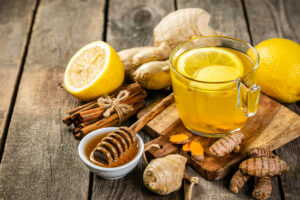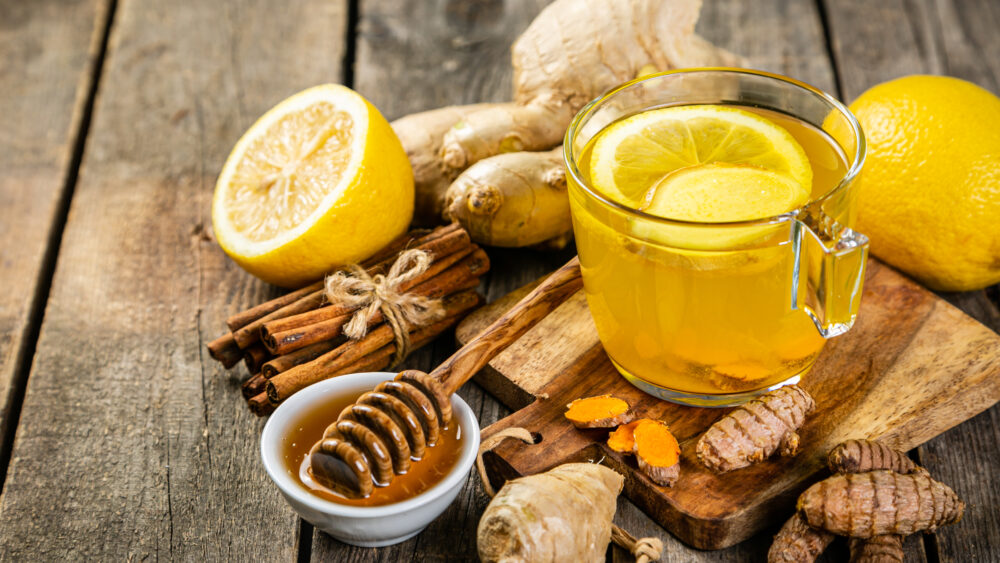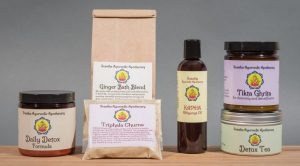 According to Ayurveda, fall is one of the best times of the year for performing a cleanse. In fact, a traditional Ayurvedic cleanse is only performed during the transitional seasons of spring and fall, and otherwise avoided during the more intense months of summer and winter. Since there are countless ways to perform a cleanse, it is extremely important to take into account the seasonal elements to perform a safe, healthy, and efficient cleanse.
According to Ayurveda, fall is one of the best times of the year for performing a cleanse. In fact, a traditional Ayurvedic cleanse is only performed during the transitional seasons of spring and fall, and otherwise avoided during the more intense months of summer and winter. Since there are countless ways to perform a cleanse, it is extremely important to take into account the seasonal elements to perform a safe, healthy, and efficient cleanse.
Fall is a great time of year to perform a cleanse for multiple reasons. Fall is a symbol of transition in our environment, and since our environment has a strong effect on us as individuals, this is also a great time for transition in our own lives. Fall also tends to be milder in weather, typically being neither too hot nor too cold. According to Ayurveda, cleanses should be avoided during more extreme weather months (i.e. summer and winter). Performing a cleanse when it is too hot or too cold may weaken the body, which needs to be strong during times of intense weather to avoid depletion, illness, and imbalance.
Summer tends to be a time of travel, late nights, and more social activities. Therefore, another great reason for a fall cleanse is to reset the system and flush out any built-up toxins that may have accumulated during this time. Summer is also a time of Pitta (fire/heat) accumulation, and by the end of summer/beginning of fall, Pitta can be at its worst. Therefore, a fall cleanse should focus on flushing the accumulated toxins in the system while also addressing the accumulated Pitta (heat) that has been building up over the last several months.
Although there may be Pitta accumulation in the body, fall is actually a season of Vata. So to help balance the cold, dry, and restless qualities this season brings, it is essential to favor cleansing substances and practices that support the warm, oily, and stable qualities. If this is not considered during a fall cleanse, issues such as insomnia, dryness, anxiety, depletion, and low immunity can easily sneak in.
Fall Cleansing Tips
1. Avoid juice cleanses.
Being the season of Vata, juice cleanses should not be performed due to their cold, raw, and rough nature. Taking in only juice for a several-day period will increase Vata, which is already in excess due to the qualities of fall. This can bring about consistent feelings of coldness, depletion, poor circulation, dryness, gas, constipation, lightheadedness, anxiety, and sleep issues. The same holds true for other liquid cleanses, such as the Master Cleanse and water fasts, as these should be avoided during this time of year as well.
2. Favor a mono-diet cleanse using warm, well-cooked foods.
The most well-known dietary cleanse in Ayurveda is the infamous Kitchari Cleanse. Kitchari is warm, mushy, well-cooked, and well-spiced, making it an amazing option for a fall cleanse. If Kitchari is not a favorite of yours, other mono-diet options for a fall cleanse are chicken soup, veggie soup with quinoa, mung dal and veggies, or red lentil soup with veggies. As long as the ingredients are simple, easy-to-digest, well-cooked, well-spiced (e.g. turmeric, ginger, fennel, cumin, black pepper, fenugreek), and stay monotonous (meaning NO other foods), it should be a good option. Vata Churna can also be added to the Kitchari or soup to increase digestion while reducing Vata.
Discover our Kitchari Cleansing Kits!
Try our Best Basic Kitchari recipe!
3. Incorporate lots of warming oils in your food.
Ayurveda uses oils generously during a cleanse to lubricate the tissues to support healthy elimination of toxins. During the fall, a warming oil should be added to every meal to keep the body warm and decrease dryness. The best oil for Vata is sesame oil, but ghee is considered tri-doshic and can always be used as well. If you are using Kitchari for your cleanse, cook the Kitchari using sesame oil and then add an additional teaspoon of plain, organic ghee to each serving.
Try our grassfed, organic ghee here!
4. Sip on hot-warm water throughout the cleanse.
Warm water helps to keep the body warm and is a great aid in facilitating a cleanse. Believe it or not, warm water is powerful at flushing toxins from the system and increasing the digestive fire (Agni). This also helps to keep the system hydrated during this dry time of year. Begin each day with 16 ounces of hot water and continue to drink at least 6-8 cups more throughout the day (between meals); feel free to add lemon or lime if desired.
*Always avoid all cold or iced beverages during a cleanse, and avoid drinking too much water with food.
5. Sip on warm herbal tea throughout the cleanse.
Drinking warm herbal tea throughout each day is a gentle but effective way to jumpstart your cleanse, enhance detoxification, and support healthy digestion and elimination. Begin to incorporate these teas the week before your cleanse to prepare your body; then, during your cleanse, drink 1 to 3 cups of a cleansing herbal tea each day.
The best options for the fall season include CALM Tea, Detox Tea, Tulsi Synergy Spice Tea, fresh ginger tea, tulsi tea, CCF tea, or ginger, turmeric, and tulsi tea. A cleanse should be free of all sugar, and therefore, no sweeteners (even honey) should be used until after your cleanse is complete.
6. Take Tikta Ghrita each morning of the cleanse.
Tikta Ghrita is the medicated ghee taken before and during most Ayurvedic cleanses. It is extra essential during a fall cleanse to balance the Pitta (heat) that has accumulated throughout the summer season. Tikta Ghrita is a ghee infused with powerful bitter herbs specific for detoxification, Pitta imbalance, liver issues, and clearing the complexion. Take 1 tablespoon each morning on an empty stomach, 3 to 7 days before the cleanse, and each day during the cleanse itself.
Purchase our organic, handcrafted Tikta Ghrita here!
7. Perform a warm oil massage with Vata Oil daily.
Another essential practice to support a fall cleanse is the Ayurvedic self-oil massage known as Abhyanga. This is perfect for reducing Vata in the fall season, while also aiding in detoxification by releasing the toxins that are stored in the deep tissues. This is best done with Vata Massage Oil, but if this is not available, refined sesame oil is the next best oil for the fall season. Perform this self-oil massage each night before bed for 3 to 7 days before the cleanse, every night during the cleanse, and about 3 times a week post-cleanse.
Purchase our handcrafted Vata Massage Oil here!
Click here for full instructions on the Ayurvedic Oil Massage (Abhyanga).
8. Sweat each day.
Sweating, also known as svedana, is a great complement to any cleanse to detoxify the system on a deeper level. The best methods for this are by taking a ginger bath, sauna soak, or steam. Since dryness is prevalent in the fall, it is helpful to do the oil massage directly before or after the sweating to avoid drying out the body (especially with a dry sauna). Perform one of these sweating measures every day for 3 to 7 days before the cleanse, every day of the cleanse, and 3 times a week post-cleanse.
Discover our DIY Ginger Detox Bath!
9. Perform gentle restorative Yoga each morning.
A great complement to a fall cleanse is the grounding practice of restorative Yoga. This can be done in a classroom setting or, even better, at home with some pillows or bolsters (see pictures below). Gentle forward folds, reclined seated postures (i.e. supta virasana, supta badhakonasana, supta padmasana), or “legs up the wall” are all great postures for this time. Stay in each pose for several minutes, using a pillow to hold you up. Perform a couple of these Vata-soothing, stress-reducing postures each day of the cleanse and several days each week post-cleanse to work on both the body and the mind.
*Scroll down below for pictures of these restorative postures!
10. Perform the herbal enema known as Dashamula Basti.
For those looking for a more intense cleanse than a mono-diet, an herbal enema (Basti) is a great tool for this. Dashamul Basti is extremely beneficial for clearing out the colon while simultaneously reducing Vata. This is one of the five main cleansing therapies of the traditional Ayurvedic cleanse known as Pancha Karma, and is a must for any serious fall cleanse. Since this is a more involved therapy, it is recommended to have guidance from a knowledgeable practitioner during this therapy (if you are a newbie).
Purchase our complete Herbal Enema Kit here!
11. End your cleanse with Rejuvenation Therapy.
Rejuvenation therapy is an essential part of any post-cleanse, but even more so for the fall season to avoid Vata imbalance. A cleanse is basically an intelligent (hopefully) way to deplete the body. Therefore, the week after the cleanse, the energy will still be low, and both food and activity should be greatly monitored and slowly added in carefully. While this is occurring, the anabolic (reducing) cleansing therapies should begin to be replaced with more healthy catabolic (building) rejuvenation measures. This includes diet, lifestyle, and herbal medicine that are considered rasayana (aka rejuvenative), such as taking Rasayana Ghrita (Rejuvenation Ghee), eating Rejuvenation Kitchari, and taking the Rejuvenating Ojas Drink.
Try our Rasayana Ghrita (Rejuvenation Ghee) here!
Discover our absolutely delicious Rejuvenation Kitchari Recipe!
Click here for more information on How to Perform Rejuvenation Therapy.
Restorative Yoga Poses for a Fall Cleanse

Restorative Viparitakarani (legs up the wall) with a pillow.
Supta Virasana (reclined hero’s pose) with pillows.
Restorative Janushirsasana (head to knee pose) with bolster.

Suptabadhakonasana (reclined butterfly pose) with pillows.
Find all of your Kitchari Needs here!
Purchase our 7-day Herbal Detox Kit here!








Love this article. I learned so much. Will send all my students this information as they approach the Fall Season. I’m hoping to guide our group in a group cleanse. Thank you.
Hi Lynne,
Thank you for writing in! I am so happy you found this article helpful and I hope your students can benefit from it as well!
Happy cleansing!
Namaste,
Danielle
Excellent article and tips. Can this cleanse be followed while breastfeeding? I am currently nursing a 2.5 year old but in desperate need of a cleanse. Are there practices that should be avoided or adjusted? Thank you!
Hi Ebony,
While you are breastfeeding it is not recommended to perform a cleanse. With breastfeeding you need to be nourishing your body and eating plenty of calories, making even a mono-diet of kitchari not suitable. Taking strong cleansing herbs is also not recommended since the herbs and the toxins can end up in your breastmilk.
For now, you may wish to sip on cleansing herbal teas (e.g. CCF Tea, Ginger Tea, Detox Tea) which are much milder than other forms of herbal medicine. You can also perform a Dashamul Basti (Ayurvedic herbal enema) which is both cleansing and grounding while breastfeeding. You can read more about the Ayurvedic enema therapy here or purchase our enema kit here.
Let me know if you have any further questions!
Be well:)
Namaste,
Danielle